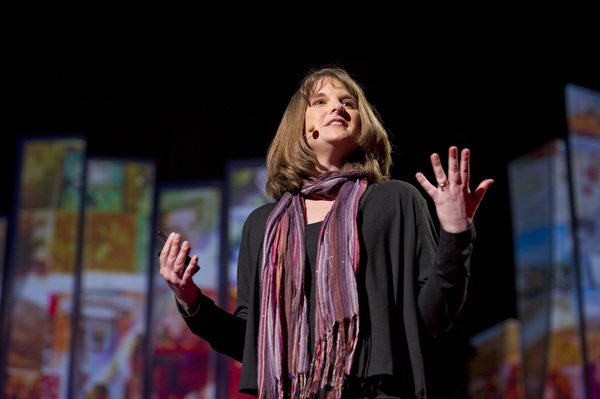Photo: James Duncan Davidson
Kate Messner begins by asking us, “How many of you have ever played with Legos?” Those of us who have (which is most) already know about world building, and the power of What If? Messner is a writer, and all of her books grow out of What If. “What If there was a worm farm in a school cafeteria? What if we could see everything happening under the snow? What if a sea monster enrolls in a school for fish?”
But imagination has a darker side as well. “What if I fail my test, or mess up my TEDTalk?”
When Messner writes a new book — say, one about a future where climate change has happened, and kids have to save the world — that world has to be real for her, before she can make it real for the readers. She plots out all the wars, changes in international relations. She hand-picked every head of state for next 38 years. (An exercise she recommends if you’ve ever been disappointed by the results of an election.) She plays the whole thing out as a movie. If this happens, what next? Most important, what are the unintended consequences of various decisions?
Many adults are worried about kids reading apocalyptic fiction, but she thinks it’s a positive thing. She thinks they’re really using it as a guide for how not to build a better world. After all, if you’re trying to build a better toaster, you’ll start with your current, bad, toaster, then work out how to fix it. What if we do that with our real world? Start with what went wrong, then figure out how to make it right.
Building a new world is going to involve collaboration in new ways and making space at the table. That’s already underway, with the 2012 TED Prize, or DARPA’s Fold-it project. John Hunter’s TEDTalk involved kids solving major world problems.
Kids are naturally gifted world-builders. They have brave imaginations, wild fresh ideas, and are not afraid of messing up. What if we brought kids to the conversations? What if’s can be powerful, and the darker ones can whisper to us at night, “What if it’s too late, and there’s nothing we can do…. Well, what if there is, and it’s not too late?”

Comments (19)
Pingback: SCBWI Winter Conference: A Weekend with the Tribe
Pingback: Publishing Opinions | How Do Writers Create Fictional Worlds?
Pingback: How Do Writers Create Fictional Worlds? - GalleyCat
Pingback: Teachers Write: Nurturing Creativity
Pingback: Book Review: Eye of the Storm
Pingback: Julie True Kingsley: Teachers Write « NESCBWI Kidlit Reblogger
Pingback: Teachers Write | Julie True Kingsley's Blog
Pingback: Teachers Write 6/15 Guest Post with Mike Jung
Pingback: Writing & Fear: An open letter to the #TeachersWrite community
Pingback: Julie True Kingsley: NESCBWI Conference~Keeping It Real! « NESCBWI Kidlit Reblogger
Pingback: NESCBWI Conference~Keeping It Real! | Julie True Kingsley's Blog
Pingback: AC Gaughen: You are Infinitely Powerful « NESCBWI Kidlit Reblogger
Pingback: Don’t Diss Dystopia
Pingback: Geek Media Round-Up: March 8, 2012 – Grasping for the Wind
Pingback: TED2012: Full Spectrum – Photos from a Magical Week